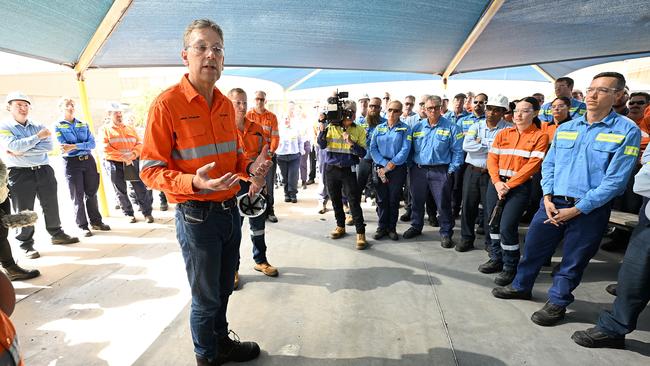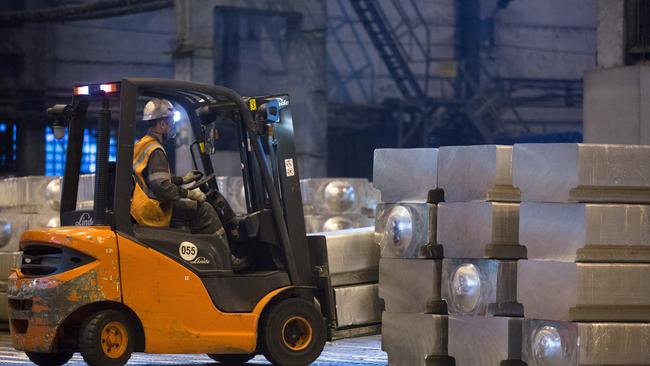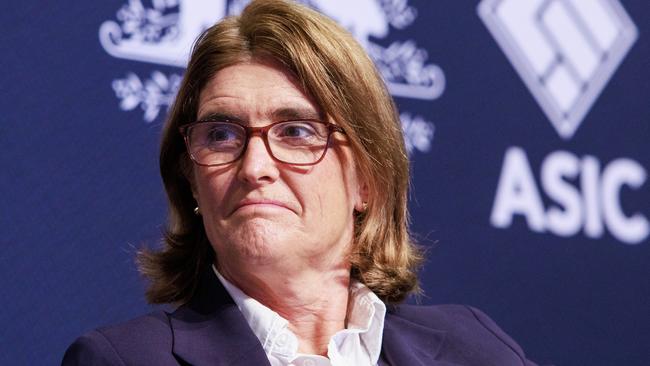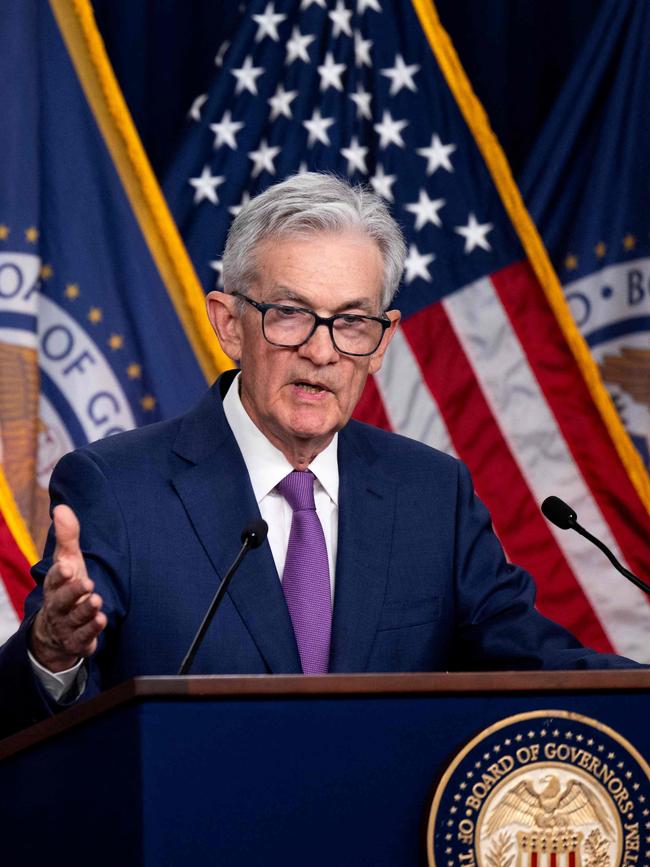Ruling on Rio Tinto’s Russian aluminium headache clears the air
A court has backed Rio’s refusal to deal with Russian steel giant Rusal in a battle over Gladstone aluminium.

Business
Don't miss out on the headlines from Business. Followed categories will be added to My News.
As Rio Tinto boss Jakob Stausholm prepares to travel to the vast Pilbara iron ore mines from his temporary base in Perth, one less thing he needs to worry about is getting tangled between a spurned Russian partner and sanctions stemming from the Ukraine war.
The risks of getting caught up in geopolitics are always high for a multinational miner like Rio with customers and operations in all corners of the world. But it seemed so unlikely it would happen this close to home.
In a decision that removes any doubt around the protections in place when contractual obligations crash into government sanctions, Rio Tinto’s position has been vindicated by the Federal Court after the miner refused to play ball with its minority partner in the Gladstone aluminium plant.
Through several local subsidiaries Russian aluminium giant Rusal has a 20 per cent stake in Gladstone with Rio holding the balance. The venture agreement gives Rusal the right to access 20 per cent of the processing capacity from the plant from bauxite also supplied by Rio. When the Australian government followed Europe and the US imposing tough sanctions on Russia in March 2022, the bans extended to the direct and indirect export of alumina to Russia.

As the ban were being finalised, Rusal’s Australian subsidiary, the Alumina and Bauxite Company (ABC), gave repeated undertakings to Rio Tinto it would comply by refusing to make any sales to Russia and it promised to not sell to third parties with prohibitions in place against on-supply to Russia.
However, Rio rightly refused this and under force majeure provisions stopped taking deliveries of bauxite from ABC and halted refining the metal on behalf of its Russian partner. Instead Rio absorbed the additional spare capacity in the plant for its own operations.
Rusal’s ABC launched legal action in late 2022, alleging Rio was in breach of contract in both the supply and processing of alumina at Gladstone. It claimed the sheer mechanics of processing in Australia was not in breach of the sanctions and Rio had ignored its assurances the metal wouldn’t end up in Russia.
But even Federal Court judge Michael O’Bryan, who also heads up the Australian Competition Tribunal, knocked back the promises, suggesting it would be impossible for Rio to keep track of the exports.
“There can be no doubt that … alumina delivered to ABC would have been, and would in the future be, exported to Russia for use in UC Rusal’s aluminium smelters,” Justice O’Bryan said in his judgment.
Rio Tinto was well within its rights to invoke force majeure provisions under sanctions, he found in a ruling released Thursday. Rusal’s legal action was dismissed.
A spokesman for Rio Tinto said the miner and its subsidiary Queensland Aluminium “plan to continue to operate on this basis for as long as the sanctions continue”.
With the war now dragging out and Gladstone facing a costly investment program in its bid to go green, there are questions over whether Rusal will now seek to offload the stake.
The findings come at an important time for Gladstone, where its future had been in doubt over Rio’s efforts to switch the electricity hungry operation over to renewables. Time had been running out on Gladstone which is powered by ageing coal-fired plants and a new investment cycle was needed.
Last month, Stausholm toured the operation where last week he announced the underwriting of Australia’s biggest solar farm set to generate 1.1GW of energy for the plant. Another 3GW is still needed to get around-the-clock electricity supply and this is when Rio is making a big bet on the federal government’s newly-minted Capacity Investment Scheme to tease out market players to supply the rest.
Stausholm’s visit to Gladstone had been cut short as he flew out to the remote Diavik diamond mine in Canada for several days after a plane carrying Rio Tinto staff had crashed. Four Rio miners and two airline crew died in the accident, which is under investigation.
After meeting with Canadian staff and family the CEO returned to Australia at the start of this week.
He is understood to be devastated about the accident. He has told executives in recent days it has been the worst situation he has confronted of his executive career.
RBA to hold
Everyone – including the Prime Minister and state premiers – urging the Reserve Bank to go early with rate cuts need to prepare to be disappointed.
If the powerful US Federal Reserve is anything to go by, the mantra from central banks is all about extreme caution – even as they move into this lower inflation cycle. This has some big implications over the timing of any rate cuts here in Australia.

Early Thursday the US central bank has doused hopes of an early cut – even though many in the market were betting on a March move. US Federal Reserve chair Jerome Powell says this would be “unlikely” although the easing back may happen at “some point this year” on the provision that inflation was moving back to the target range. Also in a read for Australia, the Fed’s Powell sounded some caution, noting the decision to cut rates will be “highly consequential” adding there had been past negative surprises from the economic data.
This let-down quickly hit bond markets and moved to Wall Street which marked the biggest fall in four months. Australia too has pulled back from its record high set on Wednesday, falling 1.2 per cent.
The change in mood comes right on the heels of a big shot of positive news this week, with evidence inflation is clearly falling away. The seasonally adjusted figure of 4.1 per cent for the December quarter was lower-than-expected and down sharply from 5.4 per cent from the previous quarter. At the current pace, it is conceivable that inflation moves back into the RBA’s target range by the very end of this year.
The fall has also stoked hopes there was enough room for the RBA to cut its 4.35 per cent rate earlier.

In an interview with ABC Radio early Thursday Prime Minister Anthony Albanese said he’d “like to see cuts to interest rates” in coming months. This puts him in agreement with money markets that in the past 24 hours had brought forward predictions that cuts could happen as early as May. Even the Queensland premier Stephen Miles and Western Australia’s Roger Cook were getting in on the act urging the RBA to hurry up.
However, under a brand-new management team, the RBA simply has no intention of leading the world when it comes to cooling the cash rate. And any cuts will only happen when inflation is well and truly under heel. That could be a few quarters away yet.
Consumer tailwinds
The evidence points to inflation is coming down and this is a very good thing, but as Powell suggested, there is little upside to be gained for a central bank in moving early.
Even New Zealand’s Reserve Bank, often regarded as a lead indicator for Australia, has held firm on the outlook for cash rates, currently sitting at a painful 5.5 per cent.
Australia is now moving towards a position of a number of consumer tailwinds that could stoke spending and inflation again. All things being equal as inflation eases to too does the cost of living which means the dollar goes a little further. Real wages have moved up in the past two quarters and there will be more to come with a new round of claims this year. The stage three tax cuts are so far scheduled to kick in from July. Meanwhile, companies have so far held their earnings momentum, which too means tens of billions in dividends flowing to investors around April.
More efforts to tackle the cost of living will be the centre of the Jim Chalmers’ May budget. And all these points combined mean more cash in the pockets of middle Australia. Adding to the wealth effect is the new record for the ASX (albeit the pullback on Thursday) and house prices pushing up despite last year’s hikes. On the negative side for households are higher rents, energy prices and rising insurance costs.
The Reserve Bank needs to start cutting interest rates now to take pressure off households.
— Steven Miles (@StevenJMiles) January 31, 2024
But as the US Fed reminds us, the risks are real risks for homegrown inflation.
In Australia, services inflation is stubborn, while supply chain issues are drifting back given the tensions in the Middle East. And Australia’s January manufacturing purchasing managers’ index, also released Thursday has moved into the “expansion” zone after sitting at “contraction” for most of last year.
Even with lower business confidence, this points to underlying strength at the very front lines of the economy. The big unknown is how China plans to stimulate its tepid economic recovery, this too will have a big flow on for Australia.
GSFM investment strategist Stephen Miller says central banks still have their work cut out tackling what he calls “last mile” of inflation. “The process of disinflation is frequently a disjointed one: a process of ‘two steps forward and one step back’ with the “last mile” to the inflation target proving particularly challenging,” he says.
RBA governor Michele Bullock will next week take questions for the first time under a new format where she holds a press conference following the central bank’s board interest rate decision.
It’s here you should prepare to pencil in this line from the new governor: It’s too early to tell when rates need to be cut and any decision will be data dependant.
In other words, Australia won’t be in any rush to move.
johnstone@theaustralian.com.au
Originally published as Ruling on Rio Tinto’s Russian aluminium headache clears the air



